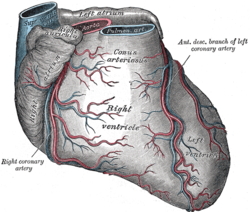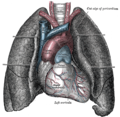What is Conus arteriosus?
It is a cone-shaped pouch that is formed from the left angle and the upper angle of the right ventricle located in the chordate heart. The pulmonary trunk originates from this structure. The sac has a smooth wall.
Also referred to as ‘’Infundibulum’’, the Conus Arteriosus acts as the entrance from the heart’s right ventricle and runs to the pulmonary trunk and the pulmonary artery. The reason why the structure is also referred to as ‘’infundibulum’’ is that the outflow track looks like a funnel that connects to the pulmonary trunk.
However, the slight difference between the Infundibulum and the Conus Arteriosus is that the former is the internal structure while the lateral is the external structure.
Conus arteriosus Synonyms
This conical sac is also referred to by various other names like:
- Cône artériel
- Pulmonary conus
- Infundibulum of right ventricle
- Outflow tract of right ventricle
Conus arteriosus Location
It is situated at the entry point of the pulmonary trunk in the heart. This conically shaped structure sits between the atrioventricular sulcus descending the left anterior and the right anterior.
Conus Arteriosus Structure
At the apex of this conically shaped structure lie the pulmonary trunk and the pulmonary valve. There is a short fibrous band that stems from the base of the aorta and the fibrous part of the atrioventricular sulcus. The part is also termed as ‘’conus arteriosus tendon’’.
Conus arteriosus Function
It allows the blood to pass without flowing into the lungs until they are formed completely and infants can breathe on their own. To put in simple words, the Conus Arteriosus helps in developing the outflow tract for the blood to pass.
The defect with the Conus Arteriosus is known as truncus arteriosus. There are associated in-born defects with the Truncus Arteriosus that form the caudal ends of the heart’s bulbus cordis that form the passageway to the right and left ventricles (Conus Arteriosus and Aortic Vestibule, respectively).
This type of birth defect is congenital that shows one large vessel from the heart instead of two. Such a heart issue with the Truncus Arteriosus welcomes various associated issues with the Conus Arteriosus region and of the entire heart.
A hole (ventricular septal defect) lying in the lower chambers of the heart, therefore, creates serious circulatory issues as the oxygen-poor blood that should go the truncus arteriosus gets mixed up with the oxygen-rich blood that is meant to reach different parts of the body. This should be treated, otherwise, it becomes fatal.
Conus Arteriosus- Truncus Arteriosus Symptoms
- Pounding heart
- Skin turning bluish (medically termed cyanosis)
- Poor feeding
- Poor growth
- An excessive feeling of sleepiness
- Shortness of breath (also known as dyspnea)
- Rapid breathing (also known as Tachypnea)
Conus Arteriosus- Truncus Arteriosus Causes
The actual reason for a hole in the heart or Truncus Arteriosus is not yet definitely found. However, the problems lies with the single large blood vessel that fails to complete its entire structure of dividing into two separate blood vessels. The issue leads to a large hole developed between the heart’s two chambers.
Aside from the hole created in the heart at the time of birth, there is another issue with the truncus arteriosus. The valve that connects from the heart’s ventricles to the truncal valve is often found damaged. It forces the blood to flow backwards into the heart instead of outward.
These following risk factors can make the matter worse:
- Children showing velocardiofacial syndrome or DiGeorge’s syndrome are likely to suffer from higher risks of the truncus arteriosus.
- Viral illness at the time of pregnancy increase the risk of congenital heart defects in the baby developing in the mother’s womb,
- Acute diabetes that is not taken care of adequately during pregnancy increases chances of birth defects in the unborn baby.
- There are certain medicines that the doctor strictly prohibits because such medicines have a higher risk of causing birth defects in the foetus.
- Smoking is another big reason for accelerating any risk in the baby when still in the mother’s womb.
Other several reasons like heart failure, respiratory problems, enlargement of the heart and high blood pressure in a pregnant woman enhance risk in causing defects in the baby’s heart due to its poor functioning when still growing inside his/her mother.
It should, however, be noted that most of the truncus arteriosus issues in infants become complicated and lead to fatal consequences. However, only a few rare cases show that the infant is growing into an adult without much complications despite the existing heart disease.
There are higher chances for such adults with inborn heart defects in the truncus arteriosus to develop pulmonary hypertension and heart failure. Under the situation, a major portion of blood bypasses the lungs completely.
Conus Arteriosus- Truncus Arteriosus Diagnosis
- X-ray- An x-ray procedure helps to detect any problem with your baby’s heart. The still images of the internal structures and organs help to show the size of the heart, accumulation of excess fluid in the heart or the presence of any abnormalities in it.
- Echocardiogram- This procedure uses the technology of emitting very high-pitched sound waves that hit the internal structure of your heart and reflect back, thus showing the exact shape of them. Thus, with the aid of the procedure, the doctor knows if there is any hole, how much blood is flowing to the lungs of your baby, etc.
Conus Arteriosus- Truncus Arteriosus Treatment
Children suffering from truncus arteriosus need to go surgery. But they need to follow these medications before undergoing the surgery:
- Ionotropic agents- The medication helps to strengthen the baby’s heart contractions.
- Diuretics- The medication increases urination, thus allowing the drainage of excess water from the body and preventing water accumulation.
Once your baby is put under the abovementioned medication, the doctor suggests a surgery that helps to:
- Close the hole in the ventricles by fitting a patch.
- Reconstruct the single aorta and recreate two separate aortas.
- Divide the upper part of the pulmonary artery arising from the single large vessel.
- Establishing a completely new pulmonary artery in order to connect the upper part of the pulmonary artery with the right ventricle.
The doctor may suggest for minimally invasive procedures as a substitute for traditional surgeries in order to avoid hassles and assure minimal distress to the baby and parents. These procedures include:
Cardiac catheterization- A catheter or small tube is put inside the leg by making a small slit therein and threading the tube slowly upwards. Sometimes the tube is used with an inflated balloon tube that allows in opening up any narrow or obstructed artery.
Stopping intake of specific drugs- The doctor may even suggest stopping taking certain drugs that may cause heart problems and pose as a threat to the unborn baby.
Truncus Arteriosus is a rare heart defect that should be treated with precautions or it may lead to fatal results for your little one. If the hole in the heart or other related issues is treated with adequate care it ensures that your heart is working fine and every part of the heart including the Conus Arteriosus is functioning normally.
Conus arteriosus Pictures
Take a look at these images of the structure to know about its physical appearance.
Picture 1 – Conus arteriosus
Picture 2 – Conus arteriosus Image
References:
http://en.wikipedia.org/wiki/Conus_arteriosus



No comments yet.